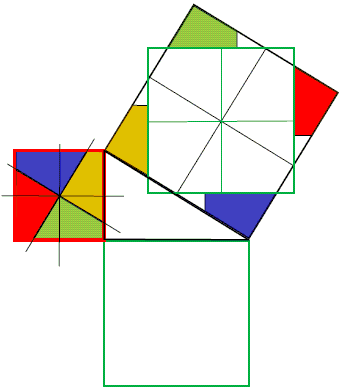A Proof Perigal and All Others After Him Missed
The central idea of Henry Perigal's proof (1872) of the Pythagorean theorem was a dissection of the larger of the two small square into four congruent pieces that fill the large on the hypotenuse after the small square had glided into its center.

In an Addendum to Perigal's note in the Messenger of Mathematics (second series) volume I (1872), pp. 103-105, J. W. L. Glaisher observed that
in Mr. Perigal's elegant proof ... the four parts into which he has divided the greater side are equal in all respects, so that the division of the squares is symmetrical. In this consists chiefly the elegance of the construction, which is in this respect ... unique.
Giorgio Ferrarese from University of Torino, Italy, has observed that Perigal's proof - praised for the symmetry of the dissection of the square on the longer leg of a right triangle - admits further symmetric treatment. His proof is based on the following diagram

The same dissection as before but now applied to the smallest square, with the middle square sliding into the center of the big one!
If you like Perigal's dissection you are bound to admire Giorgio Ferrarese's construction as well. For almost a century and a half no one noticed that Perigal's dissection had a twin. Its presence adds an enchantment to the symmetry of Perigal's proof.
Equidecomposition by Dissiection
- Carpet With a Hole
- Equidecomposition of a Rectangle and a Square
- Equidecomposition of Two Parallelograms
- Equidecomposition of Two Rectangles
- Equidecomposition of a Triangle and a Rectangle
- Equidecomposition of a Triangle and a Rectangle II
- Two Symmetric Triangles Are Directly Equidecomposable
- Wallace-Bolyai-Gerwien Theorem
- Perigal's Proof of the Pythagorean Theorem
- A Proof Perigal and All Others After Him Missed
- Dissection of a Vase
- Curvy Dissection
|Contact| |Front page| |Contents| |Geometry| |Pythagorean theorem|
Copyright © 1996-2018 Alexander Bogomolny73457385
